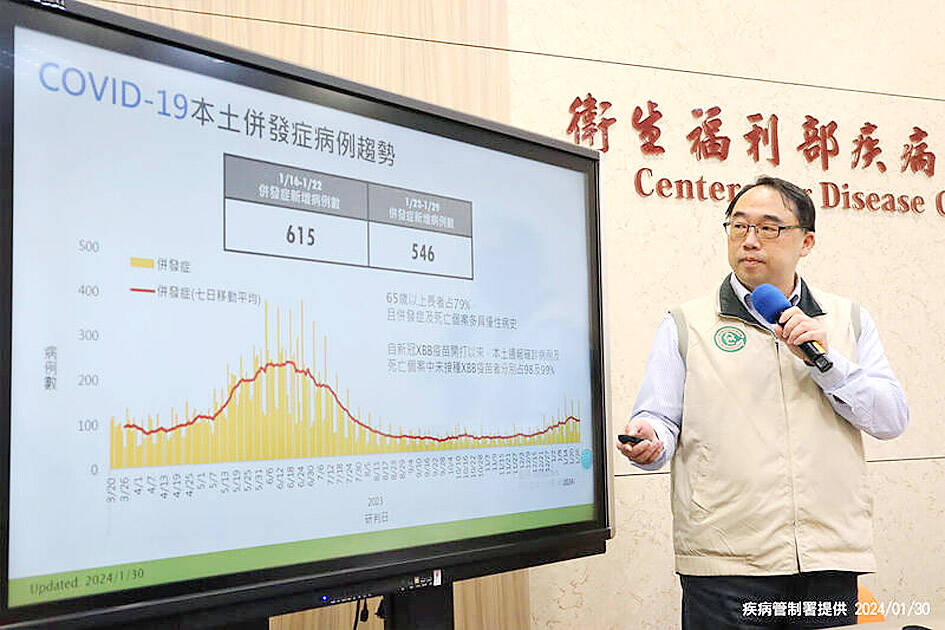The Centers for Disease Control (CDC) yesterday said that 64 COVID-19-related deaths were reported last week, the highest weekly number in five months. It said the JN.1 subvariant has become the dominant strain.
CDC Epidemic Intelligence Center Director Guo Hung-wei (郭宏偉) said 546 hospitalized COVID-19 cases and 64 deaths were reported last week, and that 79 percent of the cases were elderly people aged 65 or older.
SARS-CoV-2 genomic surveillance data from the past four weeks showed that the JN.1 subvariant accounted for 52 percent of sequenced cases, followed by the EG.5 strain at 35 percent and the XBB.1.5 strain at 7 percent, he said.

Photo courtesy of the Centers for Disease Control
The global testing positivity rate has started decreasing, but the rates in Southeast Asia and the western Pacific are still increasing, Guo said, adding that JN.1 is also the dominant circulating strain globally.
Meanwhile, 114,754 hospital visits for flu-like illness, 40 severe flu complications and eight flu-related deaths were reported last week, he said.
Of the severe flu cases, 30 people did not get vaccinated this flu season and six of those who died were unvaccinated, while the majority had underlying health conditions, Gou said.
CDC physician Liu Yu-cheng (劉裕誠) said one of the people who died was a three-year-old girl, who did not have underlying health conditions, but was unvaccinated and began suffering respiratory symptoms earlier this month.
She was rushed to hospital after developing a high fever and altered state of consciousness.
The girl tested positive for flu and acute encephalitis, so was admitted to an intensive care unit.
She died of respiratory failure after being hospitalized for about three weeks, making her the youngest person to die of flu this year, he said.
“She did not get vaccinated this flu season, and children are more likely than adults to develop severe complications and encephalitis from an infection,” Liu said.
The CDC reminded people to pay close attention to the warning signs of severe complications, such as difficulty breathing or cyanosis (skin, lips or nails turning blue due to a lack of oxygen), and seek medical attention immediately if they occur.
CDC Deputy Director-General Philip Lo (羅一鈞) said although hospital visits for flu-like illness slightly reduced last week, both flu-like illness and COVID-19 cases are still expected to peak this week.
“We predict another wave of infections after the Lunar New Year holiday ... so we are still urging people to get the XBB.1.5-COVID-19 adapted vaccine,” Lo said, adding that a new batch of Novavax’s vaccine arrived in Taiwan on Monday and is likely to be distributed next week.
In addition, more than 580,000 packs of government-funded free COVID-19 rapid test kits had been picked up by travelers at international airports and harbors as of Thursday last week, he said.
As more people are expected to arrive via the “small three links” ahead of the Lunar New Year holiday, free test kits are also to be provided at Beigan Baisha Harbor (北竿白沙港) and Nangan Fuao Harbor (南竿福澳港) starting tomorrow, he said.
In addition, the CDC is offering subsidies to hospitals willing to have doctors available to treat people with respiratory infection diseases during the Lunar New Year holiday, which begins on Feb. 8.
Non-pediatric treatment during the Lunar New Year holiday would be subsidized at NT$10,000 per patient, while doctors treating children would be subsidized NT$15,000 per patient, it said.
There are currently 157 hospitals nationwide that would be providing the service during the holiday, Lo said.

People can preregister to receive their NT$10,000 (US$325) cash distributed from the central government on Nov. 5 after President William Lai (賴清德) yesterday signed the Special Budget for Strengthening Economic, Social and National Security Resilience, the Executive Yuan told a news conference last night. The special budget, passed by the Legislative Yuan on Friday last week with a cash handout budget of NT$236 billion, was officially submitted to the Executive Yuan and the Presidential Office yesterday afternoon. People can register through the official Web site at https://10000.gov.tw to have the funds deposited into their bank accounts, withdraw the funds at automated teller

PEACE AND STABILITY: Maintaining the cross-strait ‘status quo’ has long been the government’s position, the Ministry of Foreign Affairs said Taiwan is committed to maintaining the cross-strait “status quo” and seeks no escalation of tensions, the Ministry of Foreign Affairs (MOFA) said yesterday, rebutting a Time magazine opinion piece that described President William Lai (賴清德) as a “reckless leader.” The article, titled “The US Must Beware of Taiwan’s Reckless Leader,” was written by Lyle Goldstein, director of the Asia Program at the Washington-based Defense Priorities think tank. Goldstein wrote that Taiwan is “the world’s most dangerous flashpoint” amid ongoing conflicts in the Middle East and Russia’s invasion of Ukraine. He said that the situation in the Taiwan Strait has become less stable

CONCESSION: A Shin Kong official said that the firm was ‘willing to contribute’ to the nation, as the move would enable Nvidia Crop to build its headquarters in Taiwan Shin Kong Life Insurance Co (新光人壽) yesterday said it would relinquish land-use rights, or known as surface rights, for two plots in Taipei’s Beitou District (北投), paving the way for Nvidia Corp to expand its office footprint in Taiwan. The insurer said it made the decision “in the interest of the nation’s greater good” and would not seek compensation from taxpayers for potential future losses, calling the move a gesture to resolve a months-long impasse among the insurer, the Taipei City Government and the US chip giant. “The decision was made on the condition that the Taipei City Government reimburses the related

FRESH LOOK: A committee would gather expert and public input on the themes and visual motifs that would appear on the notes, the central bank governor said The central bank has launched a comprehensive redesign of New Taiwan dollar banknotes to enhance anti-counterfeiting measures, improve accessibility and align the bills with global sustainability standards, Governor Yang Chin-long (楊金龍) told a meeting of the legislature’s Finance Committee yesterday. The overhaul would affect all five denominations — NT$100, NT$200, NT$500, NT$1,000 and NT$2,000 notes — but not coins, Yang said. It would be the first major update to the banknotes in 24 years, as the current series, introduced in 2001, has remained in circulation amid rapid advances in printing technology and security standards. “Updating the notes is essential to safeguard the integrity